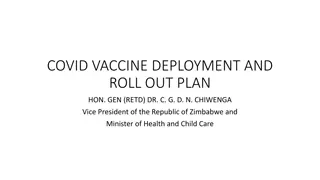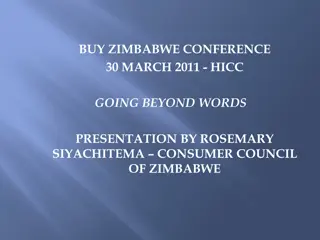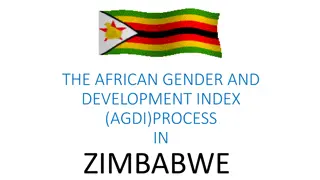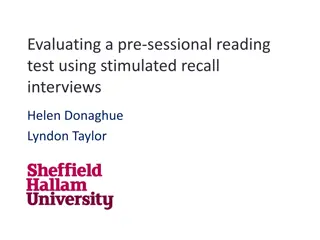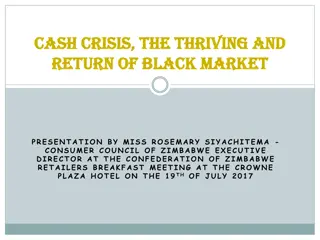Evaluation of Cost-Effectiveness of Test and Treat Program in Zimbabwe (2016-2026)
This evaluation focuses on the cost-effectiveness of the Test and Treat program in Zimbabwe from 2016 to 2026. It analyzes the background population, funding structure, decline in MTCT rate, factors fueling HIV spread, and the methodology used. The program aims to simulate transmission trends in high-risk groups and achieve significant outcomes through targeted interventions and scaling up of services.
Download Presentation

Please find below an Image/Link to download the presentation.
The content on the website is provided AS IS for your information and personal use only. It may not be sold, licensed, or shared on other websites without obtaining consent from the author.If you encounter any issues during the download, it is possible that the publisher has removed the file from their server.
You are allowed to download the files provided on this website for personal or commercial use, subject to the condition that they are used lawfully. All files are the property of their respective owners.
The content on the website is provided AS IS for your information and personal use only. It may not be sold, licensed, or shared on other websites without obtaining consent from the author.
E N D
Presentation Transcript
Evaluating the cost-effectiveness of the test and treat program in Zimbabwe 2016-2026
Background Population almost 16 million PLWHA 1.3 million 13.5% adult prevalence 980 000 on ART # virally suppressed 790 000 HIV prevalence in key pops Sex workers Prisoners (MSM) 28% 57.1%
FUNDING STRUCTURE Private Sector Clinical Care 1% PEPFAR 29% Government 10% HDP 11% Global Fund 49%
Decline in MTCT rate Decline in MTCT rate Source: Big Win
Factors fueling the spread of HIV Factors fueling the spread of HIV High prevalence of STIs Low levels of male circumcision High rates of multiple concurrent sexual relationships Incorrect or inconsistent condom use Low socio-economic status of women Distressed economic conditions ,population mobility and settlement patterns
Factors which contributed to the decline Implementation of the Zimbabwe National HIV/AIDS strategic plan which declared HIV a national emergency in 1999 Enactment of the National AIDS Council by an act of parliament Introduction of 3% AIDS levy on all taxable income in all sectors. A multi-sectoral approach Gender sensitive approach
Ctd.. Meaningful involvement of PLWHA Well packaged and targeted interventions for high risk groups Robust BCC programme leading to a massive cultural shift in sexual behaviour Rapid scaling up of PMTCT services
Methodology Methodology Goals model a dynamic compartmental model Simulates transmission trends in adults aged 15-49 in these risks categories injecting drug users (IDU) MSM female sex workers and their clients multiple partners Couples Study period: 2016-2026 3% discount rate
Sexual Mixing Males SW clients Males Non-regular partners Males PWID Males Males MSM Stable couple Females Sex workers Females Non-regular partners Females PWID Females Stable couple SPECTRUM 11
Determinants of risk of infection Susceptible Partner Infected Partner HIV infection Number of partners Stage of infection Male circumcision Number of acts per partner ART Oral PrEP Vaccination STI prevalence Topical PrEP Heterosexual, MSM, IDU contact Vaccination Condom use SPECTRUM
Probability of Sexual Transmission {1 [Ps ,g,t x (1 - rs x Rg,t x Sg,t x MCg,t x Cg,t x Prg,t x Ag,t x Vg,t)a + (1 Ps ,g,t)]n } Vaccine Prevalence in partner Probability of transmission per act by sex and type of sex Acts/partner Partners/yr Male circumcision STI prevalence Stage of infection Condom use ART PrEP use SPECTRUM Where: MC, C, Pr, A, V = 1 effectiveness x coverage
Data Sources Category of Data Source Population size DemProj, UN Population Division HIV program data (ART, PMTCT) AIM Epidemic dynamics (progression, mortality) AIM BY RISK GROUP Population size Surveys, population size studies (e.g., RDS) Global reviews: Aceijas, Caceres, Carael, Dagenhardt, Van de Pitte Condom use DHS/AIS, Key population surveys (e.g., IBBS) Number of partners Key population surveys Acts per partner Key population surveys, global defaults Percentage married Surveys Increased recruitment Prevalence patterns STI prevalence Surveillance, studies PWID: Proportion sharing needles PWID surveys Age at first sex Demographic surveys SPECTRUM
Scenario analysis Scenario analysis A comparison of CD4 <500 cells per L(Constant Coverage) and universal test and treat (UTT) using the following metrics; QALY ICER orphan years are averted per year New HIV infections averted AIDS related deaths prevented
Key findings Key findings
Key findings Key findings the UTT program cost $11.2 billion and $13.2 billion with discount and without discount, respectively. Under constant coverage the ART program cost $7.8 billion and $8.9 billion with discount and without discount, respectively. Between 0.45 and 0.61 orphan years are averted per year that an adult survives the cost of orphan care averted was $324 per every orphan year. 14.2 million life years saved 13852.8 QALYs saved 432 125(31%) new infections averted 39% AIDS death prevented ICER of $3 871.91 of UTT over constant coverage
One way sensitivity analysis Retention on ART(CC) ARV costs(CC) Discount rate(CC) Incidence(CC) Retention on ART(UTT) ARV costs(UTT) Discount rate(UTT) Incidence(UTT) -15000 -10000 -5000 0 5000 10000 15000 20000 25000 ICER sensitive to ARV costs and incidence
Discussions points UTT has huge fiscal implications upon Zimbabwe Possible challenges with defaulters and challenges with accessing second line of ART Some similar studies have showed that ART scale up might not be as effective in the long term UTT based its conclusions on RCT of which real life scenario might offer a different result Need for right mix of prevention interventions -PrEP cost effective for key population Need to watch form unintended consensus for some interventions eg sex workers reported circumcised men increased STIs due to PrEP
Conclusion UTT is a good investment opportunity for Zimbabwe as it shows big cost saving opportunity, prevention of new infections, increases in life span and quality of PLWHA. Combined with right mix of prevention strategies, country specific test and treat programs might even be more effective











